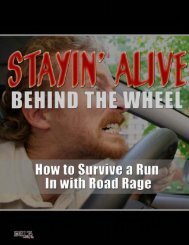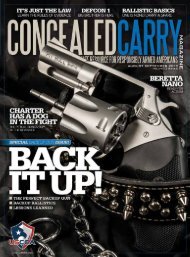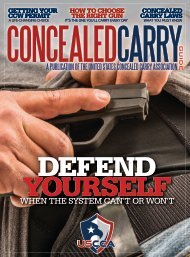Download This Issue - US Concealed Carry
Download This Issue - US Concealed Carry
Download This Issue - US Concealed Carry
Create successful ePaper yourself
Turn your PDF publications into a flip-book with our unique Google optimized e-Paper software.
THE CHALLENGED SHOOTER<br />
A plastic dummy gun allows<br />
new shooters to experiment with<br />
unfamiliar carry methods and<br />
practice drawing without fear that<br />
they might accidentally discharge a<br />
live round during the process.<br />
For challenged shooters who need<br />
to work on balance or related issues<br />
while handling a gun, using an Airsoft<br />
replica provides the best safety.<br />
tions on the shooter’s ability to draw a<br />
handgun from concealment. A method<br />
of carry will have to be selected that<br />
makes the most of the shooter’s mobility.<br />
For example, if he’s in a wheelchair,<br />
any carry position behind the hips will<br />
make it almost impossible to draw the<br />
gun with any speed. The shooter’s body<br />
will press the gun into the wheelchair,<br />
and their arm (particularly the elbow)<br />
may strike the chair as their hand goes<br />
to the grip. Cross-draw or shoulder holsters<br />
will prove much more effective in<br />
such cases, or a holster or pouch attached<br />
to the wheelchair. Use of crutches,<br />
a cane, or a walker, will also impose<br />
restrictions on the best method of carrying<br />
and drawing a handgun.<br />
In the same way, reduced upper<br />
body or arm strength will affect the<br />
shooter’s ability to control a handgun.<br />
I’ve trained many disabled shooters<br />
who couldn’t handle serious recoil, and<br />
couldn’t raise a heavy handgun to eye<br />
level for more than a few seconds, making<br />
use of the sights very difficult. Such<br />
people will have to select weapons and<br />
44<br />
calibers they can control. <strong>This</strong> applies<br />
not only to defensive use, but to training.<br />
Many disabled shooters, including<br />
myself, experience progressively increasing<br />
pain or fatigue during a training<br />
session. If their handgun adds to<br />
the problem through excessive recoil,<br />
training will become a burden rather<br />
than a pleasure; counter-productive, to<br />
put it mildly!<br />
Medication and pain<br />
If the shooter uses medications, these<br />
must be carefully assessed. Many disabled<br />
people take painkillers, muscle<br />
relaxants, nerve agents, or other medicines.<br />
I always look at the manufacturer’s<br />
instructions. If there are warnings<br />
about driving or operating machinery<br />
while taking it, then caution should be<br />
exercised in teaching the user to handle<br />
firearms. If there is any doubt at all, ask<br />
the shooter’s doctor to rule on what is,<br />
or is not, advisable. Certainly, shorter<br />
training sessions, increased supervision<br />
(preferably one-on-one on the<br />
firing line, although fewer instructors<br />
are okay for classroom lectures), and<br />
constant alertness by both student and<br />
instructor to the shooter’s physical and<br />
mental condition are essential for the<br />
safety of all concerned. Don’t ignore<br />
fatigue or wandering concentration;<br />
rather, end the training session earlier.<br />
There is also the shooter’s pain tolerance<br />
to consider. Many handicapped<br />
shooters will experience increasing<br />
pain while pushing their body through<br />
a series of shooting drills. Such pain can<br />
dull concentration, creating a safety<br />
problem, and the pain can last far beyond<br />
the shooting session, making the<br />
next day or two very uncomfortable.<br />
Instructors must take this into account<br />
and tailor the training to the needs of<br />
the shooter. Training tools, weapons,<br />
techniques, number of repetitions, and<br />
other details must be carefully selected<br />
and structured to minimize any increase<br />
in pain, and the training session<br />
must end before it becomes too much<br />
to bear. The instructor will have to be<br />
sensitive to the shooter’s needs here.<br />
Many, in their eagerness to learn, won’t<br />
<strong>US</strong>CONCEALEDCARRY.COM n CONCEALED CARRY MAGAZINE n MAY/JUNE 2011
















